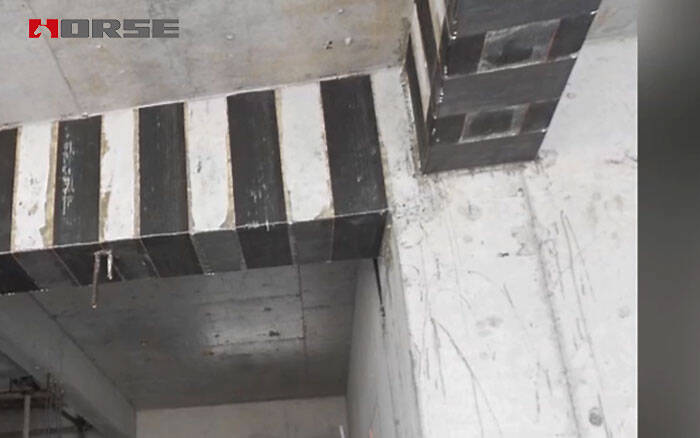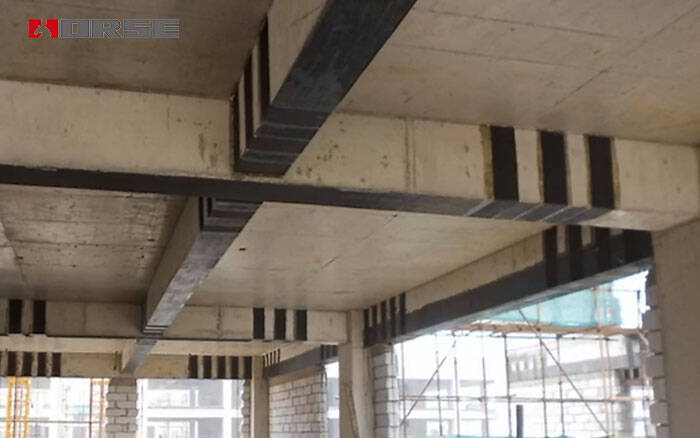Tejido de fibra de carbono para refuerzo sísmico
grietas estructurales
Para garantizar la seguridad de la estructura del edificio, se decidió demoler la escalera comercial para su rediseño y construcción. Al mismo tiempo, se repararon los elementos dañados y se reforzaron con CFRP (tejido de fibra de carbono).

La prevención de desastres sísmicos debe consistir en adoptar métodos razonables de diseño estructural sísmico, mejorar la capacidad sísmica de los edificios, para evitar daños estructurales graves y derrumbes. Sin embargo, los desastres sísmicos inevitablemente causarán daños a las casas, pero solo en diversos grados. El terremoto del 12 de mayo afectó a nuestra pequeña ciudad del condado, causando diversos grados de daño a la mayoría de nuestras casas; y las réplicas continuas han traído consecuencias más graves a estos edificios dañados. Para evitar daños más graves y derrumbes de edificios, es más importante reforzar y reparar las casas dañadas después de la identificación. Por lo tanto, la reparación de los daños causados por el terremoto en la estructura de las viviendas es una tarea importante para que la zona del desastre reanude la construcción.
1. Las causas de las grietas en el hormigón y algunos métodos principales de tratamiento en varios proyectos de hormigón, las grietas son inevitables, las microgrietas están determinadas por las propiedades físicas y mecánicas del propio hormigón. En la actualidad, las restricciones sobre grietas en diferentes países no son exactamente las mismas, pero son casi las mismas. El ancho de grieta permitido más estricto es de 0,1 mm. Cuando se producen grietas, se deben analizar las causas de las grietas y tratarlas adecuadamente para cumplir con los requisitos de seguridad estructural, aceptación de calidad y función de servicio.
2. Estudio de caso de ingeniería de daños por terremoto
Después del terremoto del 12 de mayo, descubrimos que los edificios de apartamentos comerciales dañados (estructuras de armazón de 12 pisos) en el área del centro tenían el peligro oculto de sufrir daños estructurales. Teniendo en cuenta la seguridad del primer o segundo piso de Comercio y la residencia superior, debemos pedir a las organizaciones profesionales que realicen pruebas y evalúen, y luego reparen y refuercen.
El proyecto se construyó en noviembre de 2002 (se completó en octubre de 2001) con una superficie de 20.000 metros cuadrados, un total de 12 pisos, 4,5 m en el primer piso, 3,6 m en el segundo piso y 3,0 m en los otros pisos. La estructura principal es un marco de hormigón armado colado in situ, la losa estructural es C25, los dos primeros pisos de vigas y columnas de hormigón son C40, 3 ~ 12 pisos de hormigón C30, rellenos de muro de contención. El proyecto se completó y se puso en funcionamiento dos años después. Fue el primer edificio residencial integral de la ciudad, que integró comercio y vivienda.
El 27 de mayo de 2008, el Centro de Inspección de la Academia Provincial de Ciencias Arquitectónicas inspeccionó e identificó el nivel de daño del edificio como daño leve (el primer piso de la escalera comercial entre daños moderados). Bajo la influencia de las réplicas del terremoto, el edificio sufrió nuevos daños sísmicos: el techo del primer piso (jardín del podio) se agrietó parcialmente y se produjo una filtración. El mes siguiente, el centro de pruebas de la Academia de Ciencias Arquitectónicas realizó una prueba integral nuevamente. La conclusión de la evaluación: En la prueba de profundidad de prueba ultrasónica, no se encontraron componentes peligrosos en el edificio adjunto, pero la profundidad de la grieta de los componentes locales del edificio principal y el piso comercial excedió el estándar. Se registraron registros detallados de pruebas ultrasónicas. Hay componentes peligrosos en el área de prueba. El grado de daño de las dos escaleras en el este y oeste del piso comercial ha afectado la seguridad y el uso normal de la estructura y necesita ser desmantelada y rediseñada.
Después de repetidas discusiones entre la unidad propietaria y la unidad de diseño original, para garantizar la seguridad de la estructura del edificio, se decidió demoler la escalera comercial para rediseñarla y construirla. Al mismo tiempo, los miembros dañados fueron reparados y reforzados con CFRP (tejido de fibra de carbono).
3. Tecnología de refuerzo de CFRP en ingeniería de daños por terremoto
3.1 Selección de materiales y herramientas
Adhesión de la tela de fibra de carbono y su estructura de soporte, selección de herramientas de construcción: amoladora angular, secador de pelo, tijeras, cepillo giratorio, raspador, etc.
3.2 Tecnología de construcción
Preparación de la construcción, eliminación de carga en la estructura de vigas y losas, tratamiento de la superficie del componente, imprimación de revestimiento, unión con brocha, tela de fibra de carbono en pasta, unión con brocha, solidificación estática, aceptación oculta, protección de yeso.
3.2.1 Preparación de la construcción
(1) De acuerdo con el registro de detección de ondas sonoras y el diseñador determinan conjuntamente la ubicación específica y el número de los elementos reforzados.
(2) Lea atentamente el informe de inspección y evaluación del centro de pruebas de la Academia Provincial de Ciencias de la Arquitectura y los planos de diseño y construcción de refuerzo emitidos por la unidad de diseño y examinados y aprobados por la organización de examen de planos estructurales.
(3) Se elabora un plan de construcción detallado de acuerdo con la situación real del componente reforzado.
3.2.2 Tratamiento de la superficie de los componentes de hormigón
Retire la parte de la superficie del componente (capa de yeso) y pulirla para exponer las grietas en la capa compacta de hormigón. Utilice mortero epoxi para la lechada.
Se aplica un tratamiento de endurecimiento y luego se utiliza mortero epoxi para alisar la superficie. El hormigón de la parte que se adhiere se pule de manera uniforme y el polvo de la superficie se elimina por completo y se mantiene seco mediante soplado de aire a alta presión con una bomba de aire.

3.2.3 Pasos y requisitos para pegar la tela de fibra de carbono
(1) El ancho mínimo de la lámina de fibra de carbono no debe ser inferior a 100 mm después de cortarla según el tamaño requerido.
(2) Utilice un cepillo de limpieza especial para pegar las piezas, enfríe y seque, y aplique el adhesivo de unión de manera uniforme sobre las partes que se deben pegar de la superficie del hormigón;
(3) La tela de fibra de carbono se aplica sobre la capa base recubierta con adhesivo de unión, y el adhesivo de unión se sumerge completamente en los haces de fibra de carbono mediante un raspador a lo largo de la dirección de la fibra varias veces, y el adhesivo de unión se alisa sin burbujas;
(4) Repita los pasos anteriores al pegar dos capas de tela de fibra de carbono. Después de que la superficie de la tela de fibra de carbono se seque con el dedo, pegue la siguiente capa inmediatamente y aplique un adhesivo de manera uniforme sobre la superficie de la última capa de tela de fibra de carbono.
4. Aceptación y protección tardía
Después de pegar el CFRP, manténgalo durante 7 días. Una vez que se califica la unidad de diseño y prueba, la fibra de carbono del área de refuerzo se recubre con adhesivo epoxi. Se espolvorea sobre ella una capa de arena gruesa seca y luego se agrega mortero para protegerla.
Durante el período de curado, los elementos no se ven afectados por la humedad, el fuego y la extrusión, y no se pueden agregar cargas ni vibraciones a los componentes.